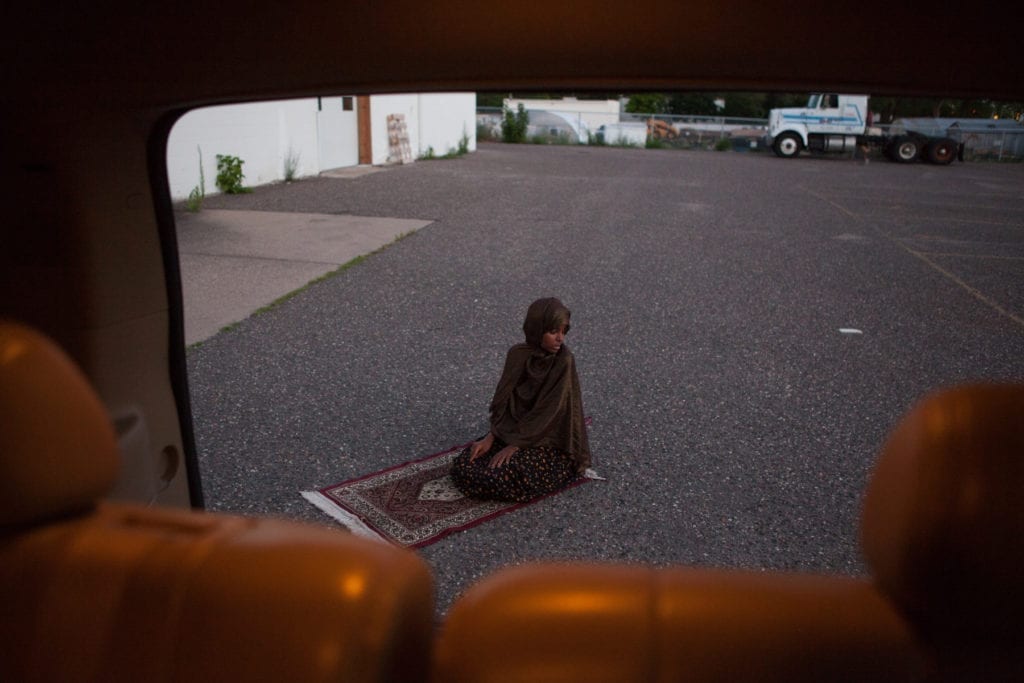Today, there are an estimated 30,000+ Somali-Americans living in the Midwest’s twin cities of Minneapolis-St Paul, a thriving metropolitan area built around the Mississippi River.
The first wave of refugees initially enjoyed the support of the local community, but two decades later, Midwestern hospitality has soured, due in large part to a growing lack of tolerance towards Islam.
Tensions were further heightened when several young Somali-Americans were accused of – and pleaded guilty to – having an association with ISIS.
 Fartun Mahamoud Abdi prays in the parking lot of a building where she will be opening a new daycare centre catering to Somali children in a suburb of Minneapolis. Ms. Abdi is also currently earning her PhD in radicalisation studies, focusing her research on the Somali community in Minneapolis. She says that instead of taking a top-down approach, law enforcement and community leaders need to listen directly to the Somali youth in order to understand the issues they are facing © Arthur Nazaryan
It was reported in The Guardian recently that more than two dozen young men left the city between 2007-11 to join terrorist group al-Shabaab in Somalia.
Fartun Mahamoud Abdi prays in the parking lot of a building where she will be opening a new daycare centre catering to Somali children in a suburb of Minneapolis. Ms. Abdi is also currently earning her PhD in radicalisation studies, focusing her research on the Somali community in Minneapolis. She says that instead of taking a top-down approach, law enforcement and community leaders need to listen directly to the Somali youth in order to understand the issues they are facing © Arthur Nazaryan
It was reported in The Guardian recently that more than two dozen young men left the city between 2007-11 to join terrorist group al-Shabaab in Somalia.
Arthur Nazaryan, a freelance photojournalist and videographer based in New York City, spent a brief period filming a documentary in Mogadishu in 2012. He wanted to shoot a broad body of work on Somali culture, but financial constraints made it impossible to return to the capital city, so he turned his eye to Minneapolis, the largest Somali community in the United States.
“I wanted to show what the community is really like day-to-day,” says Nazaryan. Having experienced Somalia’s rich, tightly knit culture during his time in Mogadishu, he wanted to show the real heart of the community, something removed from the media frenzy surrounding its associations with piracy and terrorist activity.
 Graduating high school senior Mahamed Ahmed leaves the commencement ceremony for Linclon International High School, a charter school where the majority of students are Somali. The Twin Cities has a number of such charter schools, which many Somali parents prefer because they feel it will help preserve their kids’ cultural identity © Arthur Nazaryan
But still reeling from media reports of “radicalisation” and the ensuing media focus on the community, many were hesitant to allow Nazaryan to document them. “Many members of the community feel the media only takes an interest in them when there’s bad news to report. They feel the news paints them all with the same brush.”
Graduating high school senior Mahamed Ahmed leaves the commencement ceremony for Linclon International High School, a charter school where the majority of students are Somali. The Twin Cities has a number of such charter schools, which many Somali parents prefer because they feel it will help preserve their kids’ cultural identity © Arthur Nazaryan
But still reeling from media reports of “radicalisation” and the ensuing media focus on the community, many were hesitant to allow Nazaryan to document them. “Many members of the community feel the media only takes an interest in them when there’s bad news to report. They feel the news paints them all with the same brush.”
In order to get past that, Nazaryan took the time to gain their trust – “just hanging around, making friends, often not even taking pictures,” he says. “It helped that I had been to Mogadishu and could talk to the locals about my experience there,” explains Nazaryan, who, as a Russian native, understands the often fraught immigrant experience in a nation that has historically celebrated its “melting pot” history.
 Karmel, one of two major Somali malls in Minneapolis, hosted a Quran reading competition for children in its upstairs mosque — the event drew Somali families from all over the country. Since it was revealed that the FBI used a paid informant to build its case against a group of Somali youths convicted of trying to fly to Syria to join ISIS, there is widespread suspicion and fear within the Somali community that they may be monitored or even entrapped by law enforcement © Arthur Nazaryan
“As a photojournalist, I love having access to things I may not otherwise ever get to see,” he says of photographing young Somali-American teens while participating in their high school graduation ceremonies, men observing formal prayer, and young women enjoying typical activities such as bowling. The result is Minneapolis Somalis, a series providing a window into a complex community clinging to its religious traditions while assimilating into a nation it now calls home.
Karmel, one of two major Somali malls in Minneapolis, hosted a Quran reading competition for children in its upstairs mosque — the event drew Somali families from all over the country. Since it was revealed that the FBI used a paid informant to build its case against a group of Somali youths convicted of trying to fly to Syria to join ISIS, there is widespread suspicion and fear within the Somali community that they may be monitored or even entrapped by law enforcement © Arthur Nazaryan
“As a photojournalist, I love having access to things I may not otherwise ever get to see,” he says of photographing young Somali-American teens while participating in their high school graduation ceremonies, men observing formal prayer, and young women enjoying typical activities such as bowling. The result is Minneapolis Somalis, a series providing a window into a complex community clinging to its religious traditions while assimilating into a nation it now calls home.
“There are plenty of situations I’d have no business being a part of if it were not for the fact that I was reporting on them. That’s a big privilege, as far as I’m concerned, and one of the most exciting parts of doing this kind of work,” he says of his role as a documentarian.
 Two children help a woman with her costume, designed with the colours of the Somali flag, in preparation for the annual Somali Independence Day Parade in 2015. The event, which drew hundreds of people, was hosted by Ka Joog, a Somali-run non-profit that focuses on youth outreach programmes, especially within the Somali community © Arthur Nazaryan
“Somali Independence Day is a pretty big deal in Minneapolis,” he explains. It’s an annual festival that celebrates Somali culture and heritage, when Lake Street in South Minneapolis comes alive with music, traditional dance and food stalls. The township shuts down a large part of the street for it and Nazaryan joined in, taking photos of the locals wearing traditional festive attire.
Two children help a woman with her costume, designed with the colours of the Somali flag, in preparation for the annual Somali Independence Day Parade in 2015. The event, which drew hundreds of people, was hosted by Ka Joog, a Somali-run non-profit that focuses on youth outreach programmes, especially within the Somali community © Arthur Nazaryan
“Somali Independence Day is a pretty big deal in Minneapolis,” he explains. It’s an annual festival that celebrates Somali culture and heritage, when Lake Street in South Minneapolis comes alive with music, traditional dance and food stalls. The township shuts down a large part of the street for it and Nazaryan joined in, taking photos of the locals wearing traditional festive attire.
“Photography is gratifying, to say the least. It’s a productive outlet for the way I like to interact with the world. I’m curious about people’s lives, what they’re going through, what challenges they’re facing. Photography allows me to create something tangible out of that curiosity and, hopefully, share it with others.”
To see more of Arthur Nazaryan’s work, visit his website.




